If you have a large yard to treat with liquid fertilizer, pesticide, or herbicide, a traditional sprayer isn’t going to cut it. To cover a lot of ground in a reasonable amount of time, you’ll need a backpack sprayer to get the job done. Unlike handheld or cart sprayers that you have to lug around or pull behind you, a backpack sprayer sits on your back. They have an ergonomic design with adjustable shoulder straps, hip belts, and plenty of padding, so you can wear one comfortably for hours if needed.
Backpack sprayers range in price from around $100 for basic sprayers designed for homeowners up to $500 for heavy-duty motorized models for pros, which can make choosing the right one a challenge. In this guide, we’ll break down what you need to know about backpack sprayers while reviewing some of the top models on the market.
Also In This Article
How We Picked the Best Backpack Sprayers
Backpack sprayers vary in build quality and price. Some are built to handle the rigors of daily use in the pest control and yard care industry, and others are better suited for occasional use by homeowners. Keeping this in mind, our list covers both ends of the market with reasonably priced sprayers for homeowners and high-end models for pros. We used our own experience with backpack sprayers, along with extensive research to make our selections, pouring through dozens of customer reviews and carefully comparing specs for more than 20 models.
Best Overall Backpack Sprayer
PetraTools 4-Gallon Battery Powered Backpack Sprayer HD4000
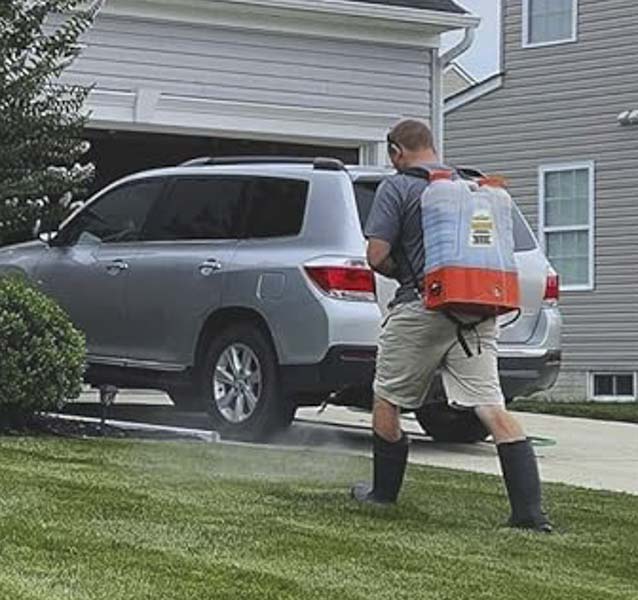
We love the long battery life and Pro-level build quality of the PetraTools backpack sprayer. It comes equipped with a rechargeable battery that will last up to eight hours, enough time to get you through a full workday. And with its six different nozzles, it can handle just about every type of application you’ll need to make with it. Its 4-gallon capacity hits the sweet spot, allowing you to carry enough product to extend the time between refills while remaining lightweight enough that you won’t mind wearing it for a full day of work. We also like the harness system, which consists of double padded cushioned adjustable straps and a belt strap. When it does come time to refill it, the wide mouth lid makes it easier to do so without spilling chemicals.
KEY FEATURES:
- Comes with six nozzles
- Padded harness with hip belt
- Long-lasting rechargeable battery
- Commercial-grade build quality
SPECIFICATIONS:
- Type: Battery-powered
- Capacity: Four gallons
- Nozzles: Six
Price: $199.99
Best Gas Backpack Sprayer
Stihl SR 200 2.1-Gallon Gas-Powered Backpack Sprayer
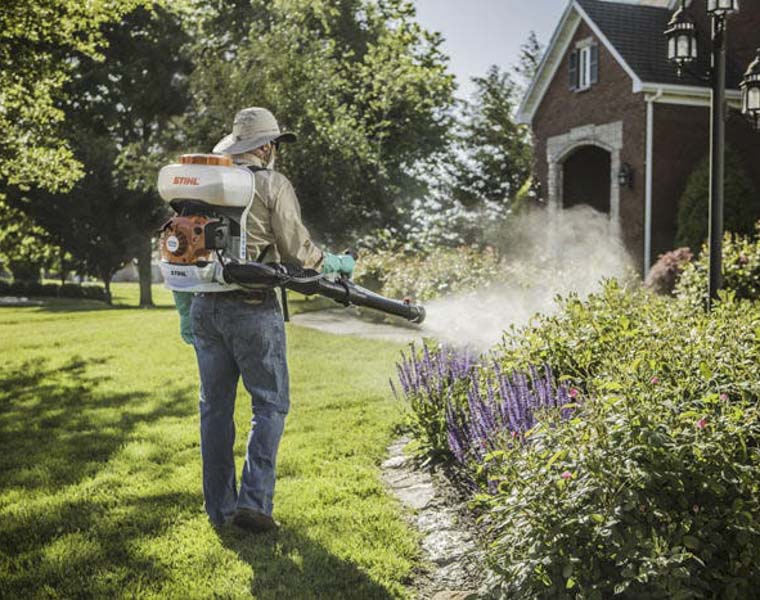

Stihl makes some of the best gas-powered machines for yard maintenance, so it comes as little surprise that it offers the best gas-powered backpack sprayer. This machine functions like a mister, allowing you to send a large cloud of product over longer distances to treat mature trees and large swathes of shrubbery. While it’s one of the heavier backpack sprayers you’ll strap on at around 35 lbs. when full, its weight is manageable thanks to a padded ergonomic harness. We also like the joystick-style handle that makes aiming the spray and controlling its output easier than a traditional wand.
KEY FEATURES:
- Long range for reaching tall trees
- Padded ergonomic hardness
- Well designed controls
- Top-notch build quality
SPECIFICATIONS:
- Type: Gas-powered
- Capacity: 2.1 gallons
- Nozzles: N/A
Price: $459.99
Best Battery-Powered Backpack Sprayer
Milwaukee M18 Switch Tank Interchangeable Backpack Sprayer 2820-21WS
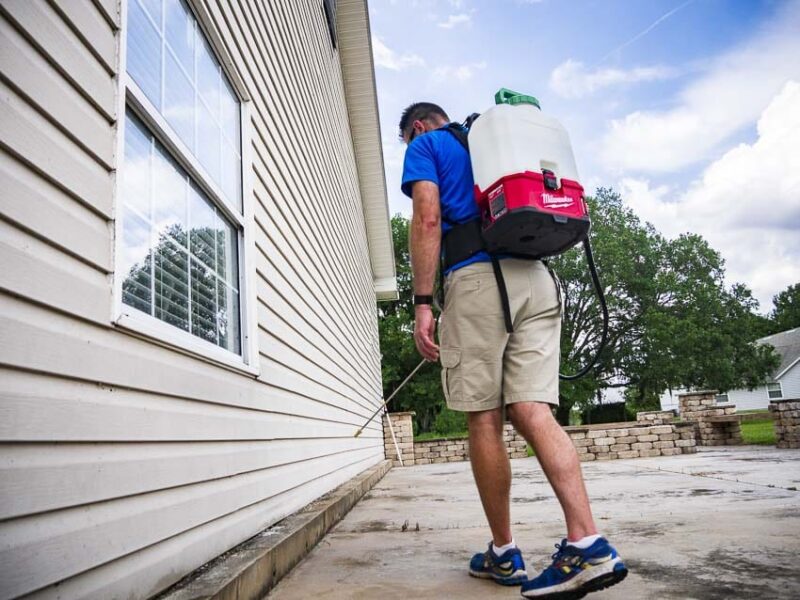

If you’re a regular reader then it should come as no surprise that we’re Milwaukee fans. And why not? Their gear isn’t just high quality. It’s consistently high quality. That goes for the M18 Switch Tank Interchangeable Backpack Sprayer (2820-21WS), which we think is, hands down, the best battery-powered unit.
No doubt, it’s great to have the reliability of the M18 platform, but we especially like this sprayer for its versatility. Thanks to a unique design that separates the motor and pump, the 2820-21WS can deliver different flow rates for multiple applications. Moreover, you can swap tanks without worrying about cross-contamination. Masons can put various sealants in different tanks, while landscapers get a specific tank for each pesticide and herbicide. As a kit, it comes with a 3.0Ah battery and charger – enough for up to 12 tanks or 48 gallons of product. If you want more runtime, any Milwaukee M18 battery fits in the compartment, including the 12.0Ah High Output.
KEY FEATURES:
- Switchable tanks for versatility (Masons & Landscapers)
- Excellent build quality
- M18 cross-compatible
- Nitrile seals
- 20 – 60 PSI with 5 adjustment settings
SPECIFICATIONS:
- Type: Battery-powered
- Up to 12 tanks per charge (w/ 3.0 Ah battery)
- Capacity: 4 gallons
- Weight: 18.3 lbs (w/ battery, power base, & tank)
Price: $449
Best Motorized Backpack Sprayer
Husqvarna Cordless Backpack Sprayer 598 96 75-01
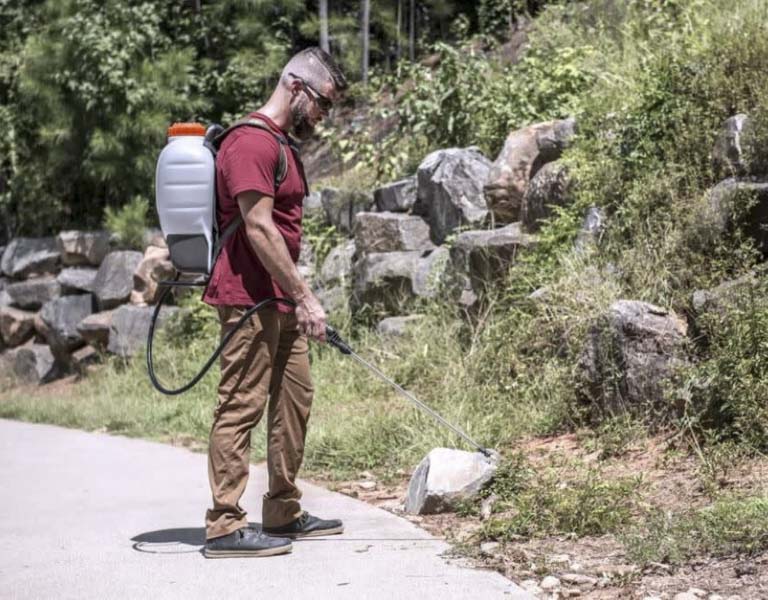

We like the top-notch build quality of this battery-powered backpack sprayer from one of the most well-regarded names in outdoor yard machines. The 4-gallon tank is made from thick molded plastic, the 25-inch wand is stainless steel, and it’s equipped with brass nozzles. There’s also a reinforced PVC hose with a strain relief nut that helps prevent it from kinking and an impact-resistant battery compartment, all of which inspire confidence that this backpack sprayer will hold up to daily use without springing a leak. Its rechargeable lithium-ion battery gets up to four hours of use or up to 50 gallons of spraying. We also like the cushioned harness and thick padding on the straps, though we wish there was a belt to transfer some of its weight to the hips.
KEY FEATURES:
- Leak-resistant hose
- Cushioned straps
- Stainless steel wand and brass nozzle
- Impact-resistant battery compartment
SPECIFICATIONS:
- Type: Battery-powered
- Capacity: Four gallons
- Nozzles: Three
Price: $259.99
Best Manual Backpack Sprayer
Field King Max Backpack Sprayer 190348
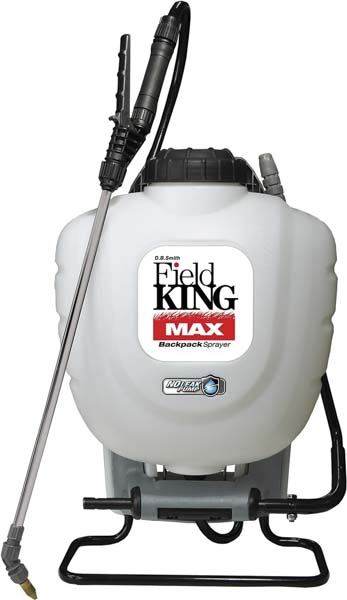

We like the high-quality construction and easy-to-use design of this manual backpack sprayer from Field King. It comes equipped with an internal pump that won’t leak and a built-in agitator that keeps powders from settling to the bottom of the sprayer as you work. There’s also a stainless steel wand with a lockable trigger, saving your hand while you’re treating larger areas, Viton seals that prevent leaks, and durable brass nozzles. There’s also a long handle that makes it easy to pump pressure into the tank. The Field King Max is one of the more comfortable manual backpack sprayers you can strap on, thanks to a beefy harness with ample padding in the shoulders and hip belt.
KEY FEATURES:
- Built-in agitator
- Durable stainless steel wand and brass nozzles
- Smooth pump action
- Padded harness with hip belt
SPECIFICATIONS:
- Type: Manual
- Capacity: Four gallons
- Nozzles: Four
Price: $106.99
Best Commercial Backpack Sprayer
M4 MY4SONS Battery-Powered 4-Gallon Backpack Sprayer
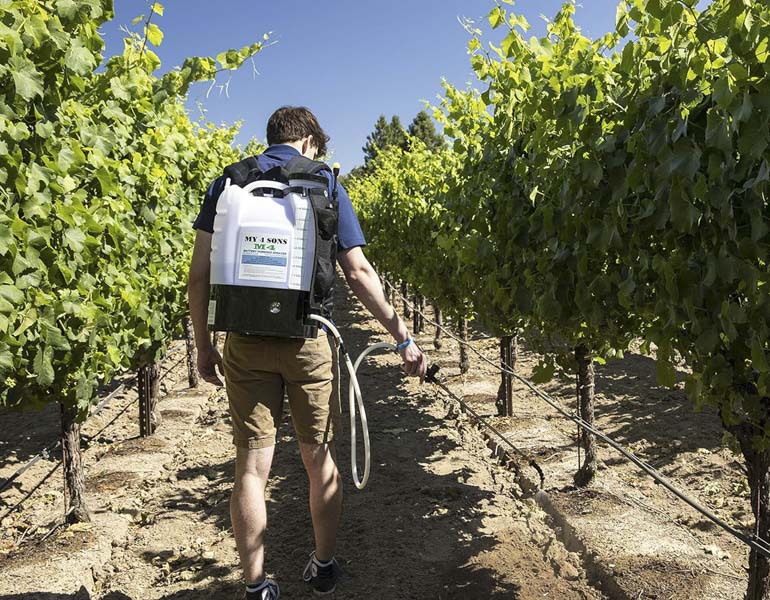

MY4SONS M4’s high performance and exceptional versatility make it one of the best backpack sprayer options for pros. You can use an included battery or fit it with an adapter to work with just about any brand of rechargeable lithium-ion battery on the market (with the purchase of an adapter kit). You can also add a mixer pump that makes it compatible with wetted powders and more abrasive chemicals. The M4 also has top-notch build quality with its all brass parts and comes with a selection of 10 different nozzles, and it’s capable of delivering fertilizer or pesticides up to 36 feet horizontally or 30 feet vertically. The M4 is also comfortable to wear, thanks to ergonomic shoulder straps and ample padding.
KEY FEATURES:
- Optional upgrade to mixing pump
- Pro-level build quality
- Is adaptable to work with most rechargeable battery brands
- Ergonomic Padded harness with hip belt
SPECIFICATIONS:
- Type: Battery-powered
- Capacity: Four gallons
- Nozzles: 10
Price: $279.99
Best 4-Gallon Backpack Sprayer
Scotts 4-Gallon No Leak Professional Backpack Sprayer 190540
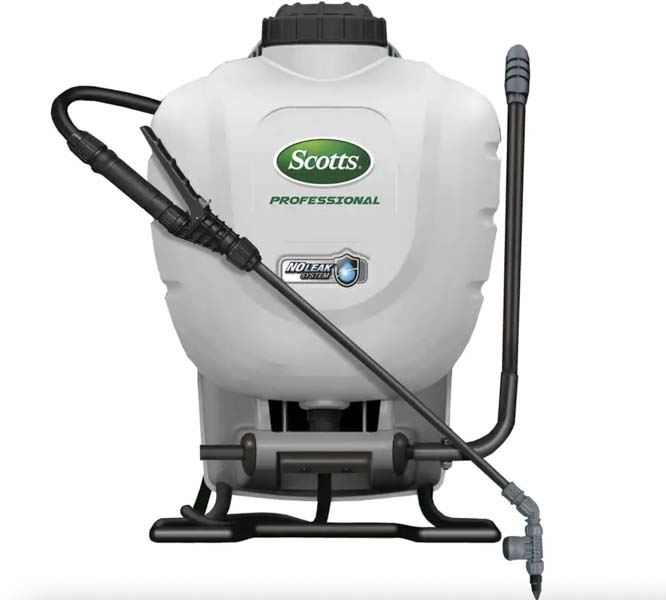

We like the value Scotts gives you with its version of the backpack sprayer. The tank is made from high-grade plastic that’s designed not to leak. There are also internal paddles that agitate the mixture as you pump, to ensure wetted powders don’t settle to the bottom of the tank. We also like the thick padding on the shoulder straps that make it comfortable to wear and the inclusion of a waist belt and chest strap that helps distribute weight across your torso. While Scotts backpack sprayer may not be the highest quality backpack sprayer on the market, it’s solidly built and comes with an affordable price tag that makes it a good choice for homeowners.
KEY FEATURES:
- Internal agitator for powder mixes
- Padded chest straps and belt
- Leak resistant design
- Reasonably priced
SPECIFICATIONS:
- Type: Manual
- Capacity: Four gallons
- Nozzles: 4
Price: $89.97
Best Backpack Sprayer Buying Guide
Capacity and Weight
Since you’ll be carrying the weight of this type of sprayer on your back, choosing one that’s comfortable to wear and distributes weight evenly on your body is key.
Tank Size
The majority of backpack sprayers come with a 4-gallon tank, which is about the maximum amount of liquid you can comfortably hold on your back. A 4-gallon tank can cover about 6,000 square feet of area, or about 1 gallon for every 1,500 square feet you cover. Gas-powered backpack sprayers have smaller 2-gallon tanks to balance out the weight of their heavier engines.
Comfort and Weight Distribution
Before you go out and buy the biggest capacity backpack sprayer you can find, remember that you’ll be carrying this load on your back. When full, a 4-gallon backpack sprayer can weigh upwards of 30 lbs. or more.
With that in mind, look carefully at the sprayer’s ergonomics. A sprayer pack with padded shoulder straps and equipped with a waist strap and chest strap will be more comfortable to wear and better distribute weight across your torso than one that lacks these features.
Pump Type and Ease of Use
You have three power options and two pump types to choose from when selecting a backpack sprayer. Each has its advantages and disadvantages.
Manual vs. Battery-Powered vs. Gas-Powered Pumps
Backpack sprayers come in manual and motorized options. Manual backpack sprayers require you to pump them by hand to maintain pressure in the tank. While these models are the most affordable backpack sprayer option, they’re only suitable for smaller jobs, such as treating a home for pests, killing weeds on a driveway, or fertilizing flower beds.
For bigger jobs, go with a battery-powered motorized sprayer that has an electric pump that maintains pressure in the tank. While this type of backpack sprayer comes with a higher price tag, it will allow you to get the job done faster and save your arm.
If you need a sprayer that requires a longer reach or broader cover, such as treating mature trees, an entire lawn, or a long row of shrubbery, a normal battery-powered or manual sprayer probably won’t cut it. For covering large areas, you’ll need a gas-powered sprayer. This type of sprayer functions more like a mister, producing a broad cloud of spray that can cover a much broader area and greater heights than a manual or battery-powered backpack sprayer. Just keep in mind that gas backpack sprayers aren’t ideal for jobs that require precision, such as treating a home with pesticides or taking out weeds in landscaping.
Considering a move from gas to cordless? Learn more about switching from gas to battery-powered lawn care equipment!
Piston vs. Diaphragm
Backpack sprayers come in two pump design options, pistons and diaphragm. The former uses a piston that moves up and down to create the required pressure inside the tank to force liquid out through the sprayer. Diaphragm pumps use a diaphragm that flexes inside the tank to create pressure.
Both have their pros and cons. Piston sprayers are capable of reaching up to 90 psi, producing a fine mist that can reach greater distances than a diaphragm sprayer, which operates at a max psi of 60.
Piston pumps work well with low-viscosity liquids, but they’re not a good choice for abrasive solutions or wettable powders, which can damage the piston. Since diaphragm sprayers don’t use a piston, they work well with wettable powders and more abrasive solutions.
Durability and Material Quality
Purchasing a backpack sprayer that’s made with quality parts is key to ensuring it remains leak-free.
Chemical Resistance and Build Quality
Backpack sprayers carry corrosive chemicals that can eat away at the sprayer’s components and have pressurized tanks that stress the hose, wand, and seals. Therefore, build quality is key to ensuring they don’t spring leaks. Look for a backpack sprayer with a tank made from heavy-duty polyethylene that won’t crack. The sprayer should also have reinforced connections where the hose connects to the tank and wand and use chemical-resistant seals and gaskets between each connection.
Hose and Nozzle Durability
Your backpack sprayer isn’t of much use if the hose fails. A good backpack sprayer will have a heavy gauge hose with reinforced connections that prevent leaks where it connects to the hose and wand.
Nozzles come in plastic and brass varieties. Plastic nozzles are okay for backpack sprayers that see infrequent use. But, if you’re using your sprayer regularly, go with one that uses brass nozzles, which will last longer and produce more accurate spray patterns.
Backpack Sprayer Uses
Backpack sprayers have applications both commercially on farms and for homeowners.
Pesticide and Herbicide Application
Backpack sprayers’ portability makes them a handy tool for applying pesticides and herbicides to crops. Since they allow for precise applications, farmers can use them to apply chemicals with minimal over-spray.
For that reason, commercial pest control companies often use backpack sprayers to administer pesticides around their clients’ homes.
Fertilizer Distribution
Backpack sprayers are also handy tools for distributing fertilizer over a broad area of crops on a farm. Gas-powered models are often used to cover broad areas, while motorized or manual sprayers are good solutions for more targeted applications.
Gardening and Landscaping
Backpack sprayers are also popular tools for professional yard care companies and homeowners.
Lawn Care and Maintenance
Backpack sprayers are commonly used by lawn care companies and homeowners to treat their lawns. Depending on the type of nozzle, they can distribute pesticides, herbicides, or fertilizers over broad areas or target individual weeds within a yard.
Targeted Weed Control
Since it’s possible to fit a backpack sprayer wand with a nozzle that delivers a narrow stream of product, backpack sprayers are also adept at targeting weeds with herbicide, while leaving surrounding plantings unscathed.
Safety Considerations When Using a Backpack Sprayer
Personal Protective Equipment (PPE)
Using a backpack sprayer means working with harmful chemicals that can cause injury should they come into contact with your eyes or skin or if inhaled. You must take precautions to protect yourself when using one by wearing the proper PPR.
Essential Safety Gear for Handling Chemicals
Wear eye protection whenever using a backpack sprayer. Go with goggles over safety glasses for maximum protection. Wear gloves and long sleeves and long pants to prevent your skin from coming into contact with chemicals. If you’re working indoors, wear a respirator to avoid breathing in any chemicals.
Safe Filling and Pressurization Techniques
Before adding pesticides to your sprayer, check it for leaks. You can do this by filling the sprayer with water and then pressurizing it. If you notice any water coming out of the seals, you’ll need to make repairs before you can add chemicals.
Once you’re sure the sprayer is leak-free, fill the tank halfway with water, then add chemicals, making sure to follow the manufacturer’s instructions for diluting the product. Next, top off the tank with more water. This practice ensures the pesticide is properly mixed while minimizing spills.
If you’re using wettable powders, make sure you use a sprayer that has an internal agitator that keeps the powder suspended inside the tank as you work.
Unless you’re using a motorized sprayer, you’ll need to pressurize the tank manually. Avoid over-pressurizing the tank or you could overstress the seals or tank, resulting in damage and leaks. You’ll know the tank is pressurized when it becomes difficult to move the lever up and down.
When the job is done, release the pressure on the tank and clean it out before storing it. Never store a tank pressurized or with leftover chemicals, as both can damage the seals, leading to leaks.
Avoiding Overexposure to Chemicals
Along with wearing the proper PPE, there are other precautions you can take to avoid exposing yourself to harmful pesticides, herbicides, and fertilizers. Avoid spraying on windy days when it’s difficult to control where the spray goes. Also, always spray downwind so chemicals aren’t blown back towards you.
If you’re using a manual sprayer, resist the urge to over-pressurize the tank, as it can cause the product to come out at too high a rate, increasing the likelihood that chemicals will splash back toward you as you spray.
Frequently Asked Questions About Backpack Sprayers
What are the Benefits of Using a Backpack Sprayer Over Traditional Sprayers?
The biggest advantage of backpack sprayers over traditional sprayers is their size. Traditional sprayers can hold one or two gallons of fluid while backpack sprayers typically hold four gallons, allowing you to cover a larger area in less time. While backpack sprayers are heavier, their backpack design makes them more comfortable to lug around than a traditional sprayer.
How Do I Properly Clean and Maintain My Backpack Sprayer?
The chemicals you put inside a backpack sprayer can be corrosive, so it’s important to clean it out after each use to prevent the seals from degrading or deposits from forming inside the sprayer hose and nozzles. Start by emptying any liquid left in the tank and storing it in a separate container or dispose of it responsibly. Fill the tank with water, then flush out the hose and wand to remove any residue.
Can Backpack Sprayers Be Used for Both Liquid and Powder Applications?
Backpack sprayers can be used for liquid and powder applications. If you use it for the latter, make sure the backpack sprayer has an agitation system that ensures the powder stays suspended inside the tank as you use it.
Are Battery-Powered Backpack Sprayers More Effective Than Manual Ones?
Battery-powered backpack sprayers aren’t more effective than manual ones, but they’re much easier to use. With a battery-powered backpack model, an electric pump maintains pressure inside the tank, so you won’t need to do so manually by pumping a lever up and down, saving time and your arm. Just keep in mind that most motorized sprayers will work for around four hours before requiring a recharge.
What Safety Precautions Should be Taken When Using Chemicals in a Backpack Sprayer?
Backpack sprayers are used to distribute pesticides, herbicides, fertilizers, and other liquids that are potentially harmful to your health. With that in mind, eye protection, gloves, and clothing that covers exposed skin are essential when using one. When using a backpack sprayer, always spray downwind to prevent chemicals from blowing back toward you.
Why You Can Trust Pro Tool Reviews
Ever check out a “review” site and you can’t tell if the author has any real experience with tools or if they’re just “recommending” the Amazon top sellers? That’s not us. We won’t recommend anything unless we’d use it ourselves. It’s all about giving you a legitimate recommendation and our honest opinion of each product.
We’ve been in business since 2008 covering tools, writing reviews, and reporting on industry news in the construction and lawn care industries. Our Pro reviewers work in the trades and have the skills and experience to know whether tools can perform well in the field.
Each year, we bring in and review more than one hundred individual products. Our team will put our hands on hundreds more at media events and trade shows throughout the year.
Pro Tool Reviews consults with innovators in the technology and design of tools to gain a broader grasp of where these products fit and how they work.
We work with more than two dozen professional contractors nationwide who review products for us on real job sites. We consult with them extensively on testing methods, categories, and practical applications.
Our site will provide several hundred pieces of new content this year absolutely free for our readers. That includes objective evaluations of individual tools and products.
The result is information you can trust because of the editorial, scientific, and real-world professional experience we collectively utilize each and every time we pick up and test a tool.





